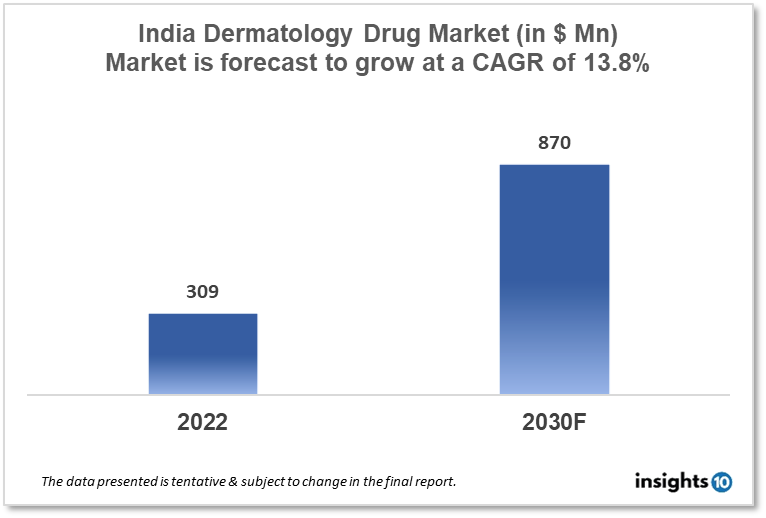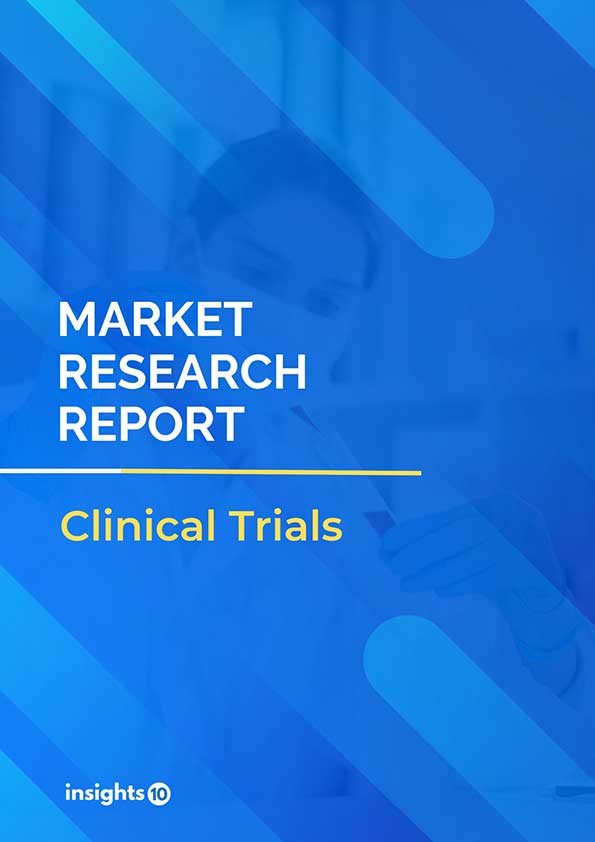India Dermatology Drugs Market Analysis
By 2030, it is anticipated that India's dermatology drugs market will reach a value of $870 Mn from $309 Mn in 2022, growing at a CAGR of 13.8% during 2022-30. The dermatology drug market in India is dominated by a few large pharmaceutical companies such as Vibcare Pharma Zee Laboratories and Sun Pharmaceutical Industries Limited. The dermatology drug market in India is segmented by drug class, drug type, prescription mode, indication, route of administration, end-user, and distribution channel. The major factors affecting the Indian dermatology drugs market are the increasing disease burden of non-communicable diseases, the lack of a proper reimbursement process, and the high cost of drugs.
Buy Now

India Dermatology Drugs Market Analysis Summary
By 2030, it is anticipated that India's Dermatology drugs market will reach a value of $870 Mn from $309 Mn in 2022, growing at a CAGR of 13.8% during 2022-30.
The market is divided into sections based on both products, such as topical medicines, systemic medicines, and others, and diseases, such as eczema, psoriasis, and acne. Due to the rising demand for topical creams, gels, ointments, and lotions, the topical medication segment is predicted to dominate the market. In May 2022, the dermatology market had a value of $1.36 Bn, and it was expected to be one of the fastest-growing therapeutic areas.
Increased healthcare spending by the Indian government and the implementation of numerous policies and initiatives to increase the accessibility and affordability of healthcare services, including dermatology treatments, are anticipated to accelerate the growth of the dermatology market in India.

Market Dynamics
Market Growth Drivers Analysis
Due to people in India dealing with factors like lifestyle changes, environmental changes, and pollution, as well as immediate factors like heat, humidity, and pollution as they resume their daily activities after pandemic-related concerns subside, the dermatology sector is expected to flourish.
Additionally, the Indian government has increased spending in the healthcare industry, which is anticipated to spur market expansion. Small and medium-sized businesses and start-ups are also becoming more prevalent in the Indian market, and they are concentrating on creating cutting-edge products to meet the increasing demand for dermatology drugs.
Market Restraints
Patent protection prevents other companies from making generic versions of many medications used to treat dermatological conditions. Prices may drop once a patent expires as the market becomes more competitive. Some dermatological drugs have side effects that may limit their use or discourage patients from continuing treatment.
Competitive Landscape
Key Players
- Vibcare pharma (IND)
- Zee laboratories (IND)
- Sun Pharmaceutical Industries (IND)
- Cipla (IND)
- Dr. Reddy's Laboratories (IND)
- Lupin (IND)
- Wockhardt (IND)
- Alkem Laboratories (IND)
- GlaxoSmithKline Pharmaceuticals
- Johnson & Johnson
- Novartis
- Pfizer
Notable Recent Deals
January 2023: For $41.63 Mn, Indian pharmaceutical company Eris Lifesciences Ltd. announced it would purchase a portfolio of dermatology brands from Glenmark Pharmaceuticals Ltd. in order to strengthen its position in the anti-fungal and anti-psoriasis markets. The agreement calls for the purchase of nine brands, including Onabet, Halobate, Sorvate, and Demelan, for India and Nepal through Eris' dermatology-focused unit.
Healthcare Policies and Reimbursement Scenario
A pharmaceutical company in India must have the Drug Controller General of India (DGCI) approval for selling a new prescription drug. DCGI is the head of the Central Drug Standard Control Organization (CDSCO) in India. DCGI is the head of the pharma regulatory framework in the country. Dermatology treatments are covered under the private health insurance plan. However, private and government schemes like PMJAY may not cover outpatient department (OPD) consultation costs and daycare procedures.
1. Executive Summary
1.1 Disease Overview
1.2 Global Scenario
1.3 Country Overview
1.4 Healthcare Scenario in Country
1.5 Patient Journey
1.6 Health Insurance Coverage in Country
1.7 Active Pharmaceutical Ingredient (API)
1.8 Recent Developments in the Country
2. Market Size and Forecasting
2.1 Epidemiology of Disease
2.2 Market Size (With Excel & Methodology)
2.3 Market Segmentation (Check all Segments in Segmentation Section)
3. Market Dynamics
3.1 Market Drivers
3.2 Market Restraints
4. Competitive Landscape
4.1 Major Market Share
4.2 Key Company Profile (Check all Companies in the Summary Section)
4.2.1 Company
4.2.1.1 Overview
4.2.1.2 Product Applications and Services
4.2.1.3 Recent Developments
4.2.1.4 Partnerships Ecosystem
4.2.1.5 Financials (Based on Availability)
5. Reimbursement Scenario
5.1 Reimbursement Regulation
5.2 Reimbursement Process for Diagnosis
5.3 Reimbursement Process for Treatment
6. Methodology and Scope
India Dermatology Drugs Market Segmentation
The Dermatology Drugs Market is segmented as mentioned below
By Disease (Revenue, USD Billion):
- Psoriasis
- Acne Vulgaris
- Atopic Dermatitis
- Eczema
- Rosacea
- Itchthyosis
- Vitiligo
- Others
By Route Of Administration (Revenue, USD Billion):
- Oral
- Parenteral
- Topical
By Distribution Channel (Revenue, USD Billion):
- Hospital Pharmacies
- Retail Pharmacies
- Online Pharmacies
- Others
Methodology for Database Creation
Our database offers a comprehensive list of healthcare centers, meticulously curated to provide detailed information on a wide range of specialties and services. It includes top-tier hospitals, clinics, and diagnostic facilities across 30 countries and 24 specialties, ensuring users can find the healthcare services they need.
Additionally, we provide a comprehensive list of Key Opinion Leaders (KOLs) based on your requirements. Our curated list captures various crucial aspects of the KOLs, offering more than just general information. Whether you're looking to boost brand awareness, drive engagement, or launch a new product, our extensive list of KOLs ensures you have the right experts by your side. Covering 30 countries and 36 specialties, our database guarantees access to the best KOLs in the healthcare industry, supporting strategic decisions and enhancing your initiatives.
How Do We Get It?
Our database is created and maintained through a combination of secondary and primary research methodologies.
1. Secondary Research
With many years of experience in the healthcare field, we have our own rich proprietary data from various past projects. This historical data serves as the foundation for our database. Our continuous process of gathering data involves:
- Analyzing historical proprietary data collected from multiple projects.
- Regularly updating our existing data sets with new findings and trends.
- Ensuring data consistency and accuracy through rigorous validation processes.
With extensive experience in the field, we have developed a proprietary GenAI-based technology that is uniquely tailored to our organization. This advanced technology enables us to scan a wide array of relevant information sources across the internet. Our data-gathering process includes:
- Searching through academic conferences, published research, citations, and social media platforms
- Collecting and compiling diverse data to build a comprehensive and detailed database
- Continuously updating our database with new information to ensure its relevance and accuracy
2. Primary Research
To complement and validate our secondary data, we engage in primary research through local tie-ups and partnerships. This process involves:
- Collaborating with local healthcare providers, hospitals, and clinics to gather real-time data.
- Conducting surveys, interviews, and field studies to collect fresh data directly from the source.
- Continuously refreshing our database to ensure that the information remains current and reliable.
- Validating secondary data through cross-referencing with primary data to ensure accuracy and relevance.
Combining Secondary and Primary Research
By integrating both secondary and primary research methodologies, we ensure that our database is comprehensive, accurate, and up-to-date. The combined process involves:
- Merging historical data from secondary research with real-time data from primary research.
- Conducting thorough data validation and cleansing to remove inconsistencies and errors.
- Organizing data into a structured format that is easily accessible and usable for various applications.
- Continuously monitoring and updating the database to reflect the latest developments and trends in the healthcare field.
Through this meticulous process, we create a final database tailored to each region and domain within the healthcare industry. This approach ensures that our clients receive reliable and relevant data, empowering them to make informed decisions and drive innovation in their respective fields.
To request a free sample copy of this report, please complete the form below.
We value your inquiry and offer free customization with every report to fulfil your exact research needs.









































